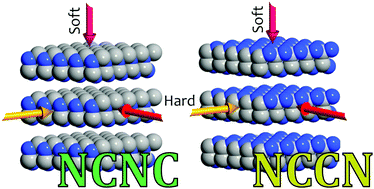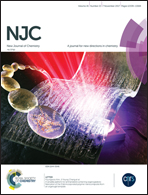Two isomeric solid carbon nitrides with 1 : 1 stoichiometry which exhibit strong mechanical anisotropy†
Abstract
Two isomeric layered carbon nitride phases in a trigonal crystal system with 1 : 1 stoichiometry, NCCN and NCNC (space group P3m1), are studied using first principles calculations and quantum theory of atoms in molecules (QTAIM) analysis, where the latter phase is predicted for the first time. Comprehensive characterization of these materials is performed to determine their thermodynamic, elastic and spectral (vibrational, UV-vis and NMR) properties. High-throughput scheme for band structure calculations along with the accurate hybrid functional HSE06 provide the indirect band gaps of 3.142 eV (NCNC) and 5.021 eV (NCCN). Phonon dispersion calculations prove that the studied materials are dynamically stable at ambient pressure. The NCCN phase demonstrates a poor spectral pattern on infrared (IR) intensities and Raman activities, whereas the NCNC polymorph is expected to be effectively detectable by both spectral techniques. The UV-vis spectra of the studied phases display absorption bands between ca. 50–150 nm, which indicates that these isomers are transparent to visible light. Elastic constant calculations indicate strong anisotropy of their Young's moduli. In the [1 0 0] ≡ [0 1 0] plane directions the modulus values are 914.6 GPa (NCNC) and 865.1 GPa (NCCN). In the [0 0 1] direction, which is perpendicular to the layer plane, the Young's moduli are much smaller and equal to 73.3 GPa and 58.4 GPa for NCNC and NCCN, respectively. The exfoliation energies are expected to be about 3 (NCNC) and 2 (NCCN) times higher than those of graphite.



 Please wait while we load your content...
Please wait while we load your content...